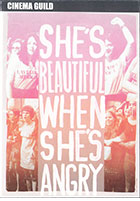
She’s Beautiful When She’s Angry 2014
Distributed by Cinema Guild, 115 West 30th Street, Suite 800, New York, NY 10001; 212-685-6242
Produced by Mary Dore & Nancy Kennedy
Directed by Mary Dore
DVD , color and b&w, 92 min.
Middle School - General Adult
Activism, Civil Rights, Feminism, Protest Movements, Reproductive Rights, History, Women’s Rights
Date Entered: 08/19/2015
Reviewed by Kathleen Spring, Nicholson Library, Linfield College, McMinnville, ORWomen’s rights advocate Virginia Whitehill sums up the primary message of the documentary She’s Beautiful When She’s Angry: “You’re not allowed to retire from women’s issues. You still have to pay attention. . . . The bitter lesson is that no victories are permanent. All our rights are like that – they’re only as good as we maintain them.” By sharing stories and reflections from more than 35 feminist leaders, filmmaker Mary Dore takes viewers on a journey that explores the history of the women’s liberation movement in the United States, starting with the early days of second-wave feminism. The film also aims to show how the issues for which women fought in the 1960s and 1970s still resonate today, and it is this goal which transforms the film from a purely educational documentary into something of a cautionary tale. Dore deftly explores the inextricable links between the women’s movement and the civil rights, anti-war, and Black liberation movements. In doing so, she highlights the work of some lesser-known activists and emphasizes common themes: equality, control of women’s bodies, and the importance of childcare.
She’s Beautiful When She’s Angry includes contemporary interviews with noted activists like Muriel Fox, Jacqui Ceballos, Rita Mae Brown, Kate Millett, and Mary Jean Collins. These interviews are interwoven seamlessly with archival photographs and period video footage of consciousness raising groups, news coverage, protests, and other events. Also included are several short bridge segments where unidentified women recite from seminal writings of the women’s movement.
She’s Beautiful When She’s Angry is more compelling and better edited than the similarly themed documentary Feminist: Stories from Women’s Liberation (2013). She’s Beautiful When She’s Angry would be useful in undergraduate courses in women’s history, feminism, women’s studies, U.S. history, and protest and reform movements. Paired with the 2012 documentary Status Quo?: The Unfinished Business of Feminism in Canada, the film would provoke a discussion of the similarities and differences in the women’s movement in the two countries. Secondary school libraries and public libraries would also benefit from adding She’s Beautiful When She’s Angry to their collections.